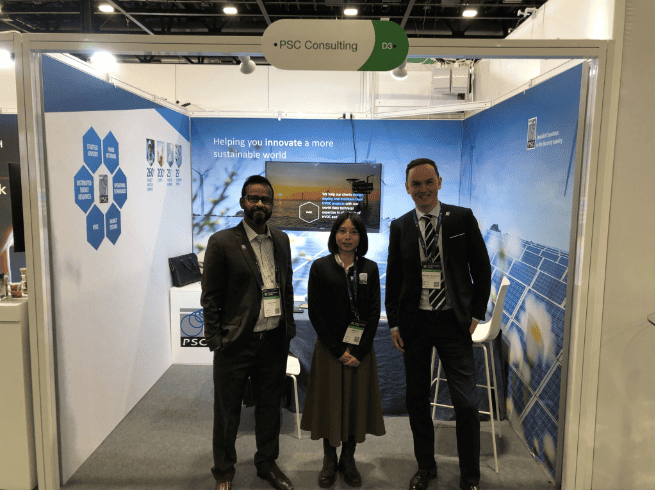The Energy Innovation Summit – organized by the ENA and held on October 31-November 1 in Liverpool UK – shows no shortage of innovative ideas in the energy sector. Topics such as whole systems storage, hydrogen, and how industry standards influence decarbonization were all on the agenda. In this post, we discuss how PSC is developing algorithms and other tools that make deploying innovative technologies and processes easier.
A matter of judgment: how to assess innovation in power systems
PSC has participated in the Energy Innovation Summit for the past three years. The 2023 Energy Innovation Summit and trade show were designed to share new ideas with electricity and gas network innovators and decision-makers in the UK. However, the deployment of new technologies, new processes, and new thinking knows no borders. With the drive to a net zero world gaining pace, what tools are available to utilities, regulators, developers and other stakeholders in the energy sector to assess and choose the innovations best suited to their needs?
These are just a few of the capabilities that PSC brings to the table.
Virtualization to model real-world challenges

PSC’s Shahab Khan, Huilian Liao, Alex Yanushkevich
As an increasing number of low-carbon technologies (LCTs) connect to distribution networks, technical constraints can limit the total amount of generation or load a network can host. In response, PSC’s systems study specialists developed the Virtual Statcom and Q-Flex approaches.
This innovative virtualization approach to network management enables DNOs to assess the capacity of their network in regard to hosting LCTs. The result is better asset utilization and reduced losses in the real world.
Forecasting and automated data analysis
Any network needs to be able to forecast demand on the system caused by variable factors such as the weather. PSC developed the Electricity Flexibility and Forecasting Systems tool (EFFS) to provide data automated analysis from multiple sources. This enables EFFS to identify system constraints as well as optimum dispatch options and flexible services to mitigate the constraint.
The tool was developed in Python and integrates with several data providers. Analysis in Power System Simulation for Engineering (PSSE) software enables flexibility as new providers and services are added to the grid. PSC is also developing a Python-based HV analysis tool that facilitates planning for future distribution networks.
Managing harmonics
Quite simply, existing solutions for managing the harmonics of a network are unsuited to the needs of dynamic networks. We’re working with Swansea University in Wales on a Network Innovation Allowance project for National Grid. The aim is to create a tool based on an algorithm that controls existing distributed generation inverters to improve the network’s harmonic levels. As part of this challenge, our power systems experts are carrying out a comprehensive review of active filter design, documentation, and relevant regulatory codes.
Results from a single inverter will be scaled up to encompass multiple inverters. In a separate project, we’re looking at how harmonics compliance management needs to evolve in an energy environment where it is increasingly difficult to attribute responsibility for harmonic distortion to a single source.
A single view of data
As a data-rich environment, there’s always a risk of data mismatches between data sets in the energy sector. The resulting inaccuracies can impact decision-making, forecasting and other processes. Working with National Grid, PSC experts in distribution and transmission networks have created an Integrated Network Model, which confirms that updates between different datasets are always correctly identified. The tool enables National Grid to combine data from asset management, graphical information and network management sources into a single dataset. As a result, automated quantitative analysis is to be carried out to identify discrepancies or other areas needing attention.
Energy storage solutions
Recent industry focus has been on developing storage solutions catering to both short-term and long-term needs. Batteries have emerged as a versatile method that balances the fluctuating energy demand across different timeframes, effectively mitigating the intermittency of renewable energy generation. Moreover, the potential of hydrogen and hydropower as viable options for long-duration energy storage has gained considerable attention. Coordination among various storage technologies is vital for effective and efficient operation in managing the grid. PSC holds comprehensive global expertise in designing and connecting Energy Storage Systems and Hydrogen generation facilities.
Flexibilities and automation
The embracement of flexible solutions and the implementation of streamlined automated processes have emerged as critical strategies along this trajectory. Explore some of the innovative projects completed by PSC in the realm of flexibility and automated network analysis (EFFS & EPIC).
Whole system solutions
A key theme today is sector coupling: integrated system solutions that harmonize and optimize interactions among diverse sectors. This holistic and multi-vector approach aims to seamlessly integrate gas, electricity, heat, and transportation systems, presenting a multifaceted solution to achieve a net-zero environment.
How PSC can help
The energy industry is continuously changing to take advantage of new technologies and developments that reduce consumer costs, ensure reliability and minimize the impact on our global environment. PSC works as a global, vendor-neutral consultancy with regulators, developers and utilities to identify and develop innovative, pioneering solutions.
